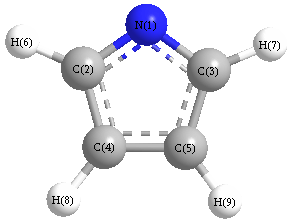Vibrational Frequencies calculated at MP2/CEP-121G*
| Mode Number |
Symmetry |
Frequency
(cm-1) |
Scaled Frequency
(cm-1) |
IR Intensities
(km mol-1) |
Raman Act
(Å4/u) |
Dep P |
Dep U |
|---|
| 1 |
A1 |
3282 |
3127 |
1.54 |
|
|
|
| 2 |
A1 |
3252 |
3099 |
0.48 |
|
|
|
| 3 |
A1 |
1578 |
1504 |
23.11 |
|
|
|
| 4 |
A1 |
1442 |
1374 |
26.93 |
|
|
|
| 5 |
A1 |
1252 |
1193 |
17.07 |
|
|
|
| 6 |
A1 |
1104 |
1052 |
47.05 |
|
|
|
| 7 |
A1 |
1076 |
1026 |
2.62 |
|
|
|
| 8 |
A1 |
881 |
840 |
10.88 |
|
|
|
| 9 |
A2 |
846 |
806 |
0.00 |
|
|
|
| 10 |
A2 |
726 |
692 |
0.00 |
|
|
|
| 11 |
A2 |
436 |
415 |
0.00 |
|
|
|
| 12 |
B1 |
863 |
822 |
1.95 |
|
|
|
| 13 |
B1 |
701 |
668 |
88.32 |
|
|
|
| 14 |
B1 |
561 |
534 |
27.26 |
|
|
|
| 15 |
B2 |
49139 |
46820 |
0.00 |
|
|
|
| 16 |
B2 |
3260 |
3106 |
86.81 |
|
|
|
| 17 |
B2 |
3245 |
3092 |
73.73 |
|
|
|
| 18 |
B2 |
1311 |
1249 |
130.19 |
|
|
|
| 19 |
B2 |
1298 |
1237 |
23.23 |
|
|
|
| 20 |
B2 |
1025 |
977 |
1.10 |
|
|
|
| 21 |
B2 |
881 |
839 |
6.85 |
|
|
|
Unscaled Zero Point Vibrational Energy (zpe) 39080.2 cm
-1
Scaled (by 0.9528) Zero Point Vibrational Energy (zpe) 37235.6 cm
-1
See section
III.C.1 List or set vibrational scaling factors
to change the scale factors used here.
See section
III.C.2
Calculate a vibrational scaling factor for a given set of molecules
to determine the least squares best scaling factor.
